
Research Yields New
Insights into Hepatitis C
Chemla Symposium Draws Luminaries and Friends
Research Yields New Insights into Hepatitis C
Hepatitis C is a contagious viral disease that leads to serious, permanent liver damage and, in many cases, death.
Often referred to as the “silent epidemic,” hepatitis C has infected some 5 million people in the United States and perhaps more than 200 million around the world. It has been billed as one of of the greatest threats to public health, and yet researchers are years away from a vaccine.
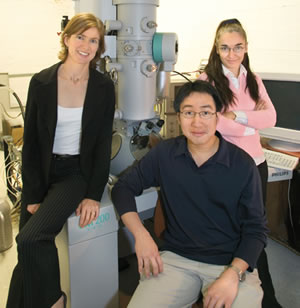
From left, Jennifer Doudna, Bunpote Siridechadilok and Eva Nogales, used this cryo electron microscope to create a 3-D model of the protein complex eIF3 that shed new light on hepatitis C viral infections.
One of the obstacles in developing a vaccine has been a lack of knowledge. Researchers have not understood how the hepatitis C virus is able to highjack protein synthesis machinery in humans for its own purpose. But help is on the way.
A team of researchers led by biochemist Jennifer Doudna and biophysicist Eva Nogales, both affiliated with Berkeley Lab’s Physical Biosciences Division, has shown that a critical protein complex called eukaryotic translation initiation factor 3 (eIF3), employs the same structural mechanics in the loading of the RNA of either humans or the hepatitis C virus to ribosomes. This is the first look on a molecular level at what happens when a hepatitis C viral infection occurs.
“A better understanding of how the hepatitis C virus (HCV) and other viruses commandeer human protein machinery by insinuating their own RNA into the ribosome could open the door to vaccines or better therapies for viral infections,” said Doudna.
Said Nogales, “Prior to this study, little was known about how eIF3 worked. Although we had some idea of where eIF3 would bind to the ribosome, there was no direct information on its structural organization, nor was there any information on how it interacted with viral RNA.”
In addition to their Berkeley Lab affiliations, Doudna and Nogales also hold appointments with UC Berkeley and the Howard Hughes Medical Institute. Their findings about the eIF3 protein complex were published in the Dec. 2 issue of Science. Co-authors of that paper were Bunpote Siridechadilok and Christopher Fraser of UC Berkeley, and Richard Hall of Berkeley Lab.
Hepatitis C is an RNA virus, which means that once an infection has begun, the HCV will create different genetic variations of itself within the body of the host, making it extremely difficult for the immune system to combat it or for researchers to develop effective antibodies. Intervention is best done at the ribosome, where the infection is first introduced. The eIF3 protein complex is responsible for initiating protein synthesis in eukaryotic cells by loading messenger RNA (mRNA) onto the small ribosome subunit, 40S. It also interacts with other translation elements, prevents premature joining of the 40S and 60S ribosomal subunits, and helps assemble active ribosomes. Until now, the structural basis for these activities has been a mystery.
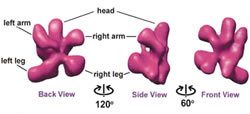
At a resolution of 30 angstroms, this 3-D model of the eIF3 protein complex shows it be a particle consisting of five lobes — analogous to a head, and a pair of arms and legs.
Using cryo-electron microscopy (cryo-EM), Doudna, Nogales and their collaborators created a 3-D model of eIF3 at a resolution of 30 angstroms. The model showed eIF3 to be a particle consisting of five lobes — analogous to a head, and a pair of arms and legs. Working with this model, the researchers were able to demonstrate how eIF3 wraps its arms and legs around a structural element of HCV RNA, known as the internal ribosome entry site (IRES), and pins it to the exit site of the 40S ribosome subunit. These interactions take place at the same location where eIF3 interacts with human mRNA.
“We now have a better mechanistic understanding of why this hepatitis virus IRES RNA can take over the protein synthesizing machinery and get around normal controls,” said Doudna. “My hope would be that in the future we could find either small molecules or mutants of some of these proteins that would allow us to interfere with that interaction between the HCV IRES and the translation machinery.”
Said Nogales, “The most important insight our collaboration yielded was that eIF3 functions the same in both protein synthesis pathways — the one the virus uses and the one the eukaryotic cell normally uses to place the mRNA in the right place within the translational machinery.”
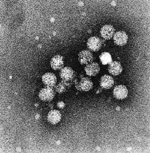
Their models showed the left arm of the eIF3 complex binding to the eukaryotic protein complex that recognizes the methylated guanosine cap at the 5’-end of the eukaryotic mRNAs (mRNA consists of a coding region sandwiched between a 5’-end and a 3’-end). By drawing the mRNA’s 5’-end cap through the ribosome entry site and towards the exit, eIF3 ensures the mRNA is properly positioned for its genetic code to be translated. In addition, their models also provided a possible explanation for how eIF3 prevents premature joining of the 40S and 60S ribosome subunits.
The next step is to improve the resolution of these eIF3 models from 30 angstroms to about 10 angstroms. This would allow the researchers to see secondary protein structures, which would give them a better understanding of the chemistry behind eIF3’s structural mechanics.
“We don’t have the molecular resolution yet to see how these interactions work and how to design drugs to block them,” said Doudna. “Nonetheless, it’s important and helpful to know where these interactions occur, and we are pushing for higher resolution so we can begin to find such targets.”
Chemla Symposium Draws Luminaries and Friends
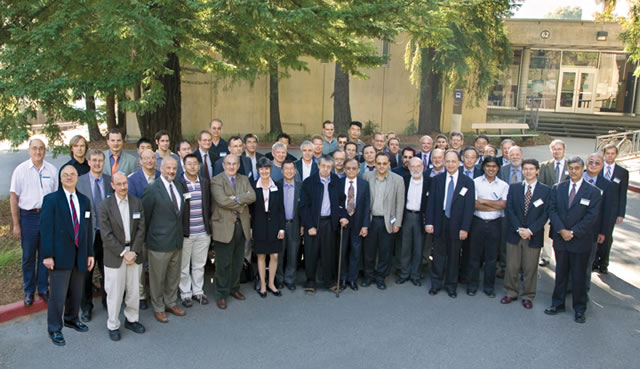
A symposium honoring the 65th birthday of Daniel Chemla, the director of Berkeley Lab’s Advanced Light Source who is retiring, drew a large audience that included current and former Berkeley Lab Directors Steve Chu and Chuck Shank, and current and former Deputy Lab Directors Graham Fleming and Pier Oddone. During the “Molecular Nanoscience Workshop,” which was held on Nov. 21 in the Building 66 Auditorium, Chemla was awarded a plaque bearing his name and likeness, which will grace the “Chemla Seminar Room” in the Molecular Foundry, the soon-to-be-completed center for nanoscience research that was Chemla’s brainchild. Also unveiled was a special “Molecular Nanoscience” edition of the journal Chemical Physics, which was published in Chemla’s honor. A beautiful tribute in the form of a slide show, as well as an honorary doctorate and medal from the Ecole Normale Superieure (ENS) institute in Cachan, France, where Chemla once worked, were presented by Joseph Zyss, a close friend and colleague of Chemla’s at ENS. Chemla was accompanied at the symposium by his wife, Berit, and his son, Yann, who, on behalf of Chemla, thanked students, colleagues, and the symposium’s organizing committee. A reception and dinner were held at the Berkeley Faculty Club followed by a retrospective of Chemla’s career. Chemla is widely recognized as one of the world’s foremost authorities on the optical and electronic properties of materials. During his tenure here at Berkeley Lab, he at one point simultaneously held directorships of both the Materials Sciences Division and the ALS. He is credited with having led the ALS into becoming one of the nation’s premier scientific user facilities, while at the same time continuing his own outstanding research effort.
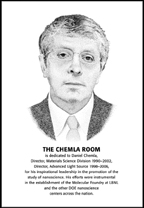
To commemorate the dedication of the Daniel Chemla Conference Room, a plexiglass plaque was created by illustrator Flavio Robles of the Creative Services Office. The plaque features a portrait of Chemla which Robles drew from a series of photographs.
Employee Travels to Aid Hurricane Victims in Ravaged Areas as A Red Cross Volunteer
story author/sub-title
The images of Hurricane Katrina’s devastation were too much for Gayle Peuser, team lead for the Macintosh/PC Support Group. “I was profoundly moved and felt I could make a difference,” she said. The hurricane hit on Monday, Aug. 29, and by Thursday, Sept. 1, she had registered with the local chapter of the AmericanRed Cross in Oakland. On Sept. 8 she completed her Red Cross training in “Mass Care” along with some 100 other volunteers.
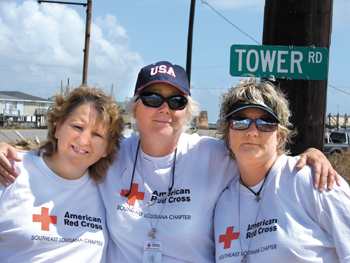
(Left to Right) Ruby Ackerman (Fargo, N.D.), Gayle Peuser (Alameda, Calif.), and Christie Hoffman (Minatare, Neb.) in Grand Isle, La.
Typical Red Cross training takes about eight hours, but because of the massive scale of the disaster, Peuser’s training took three days. She knew her work would not be easy, but she was ready to help. “Katrina/Rita victims suffered so much loss,” she said. “It seemed like a small thing for me to go and help any way I could.”
So on Sept. 24 Peuser flew to Baton Rouge for a three-week rotation. Hurricane Rita was still in the area, so she was assigned to the Houma Civic Center shelter in Houma, La. At the high point of her rotation, the shelter was serving 745 people seeking refuge from the hurricanes’ devastation.
“The experience was very humbling — physically and emotionally challenging. At times it was an emotional roller coaster. You witness unforgettable damage and hear horrific stories of survival. But in the midst of all the structured chaos, the hope, strength and resilience of the families keep everyone going — from local volunteers and national agencies to the management team at the Houma Civic Center. We were resolute that we would get through it together, and no one would be left behind.”
And the work did not end once Peuser returned home. In response to the losses she had seen, she became part of “Adopt a Family for the Holidays,” a program that links families in Terrebonne Parish, La. with the merchants of Wal-Mart and Target Stores.
“The families have lost so much, and it will be especially hard for them this time of the year,” she said. “We would like to help make this particular holiday better for them, and we hope individuals, businesses, and other organizations will participate in adopting a family’s holiday wish list. Buying a pair of pajamas, crib sheets or even a bicycle for a young child, would make a tremendous difference in their lives.”
If you would like to buy a holiday gift for a for Katrina/Rita family the webpage is: www.amazon.com/ gp/registry/2LS16SBZDXQSK
If you would like to learn more about the project or volunteer, please contact:
Christie Hoffman:
cmhoffman@hotmail.com
Ruthanne Medearis:
r_medearis@hotmail.com
(504) 401-4770
www.teamstogether.org/adopt.html
“It was a life-changing experience, and I’ve made many friends who I thank for their support while in Houma,” Peuser says. She is continuing as a Red Cross volunteer for local/national disaster response teams and training in other Red Cross support areas as well. To see more of Peuser’s photos from her rotation in Louisiana, go to homepage.mac.com/gdpeuser/Menu72.html
Lab Looks Forward to Its 75th Anniversary Next Year
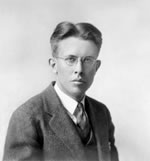 Ernest O. Lawrence
Ernest O. Lawrence
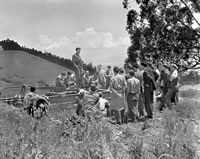 Lawrence speaks to his staff on the future site of Berkeley Lab
Lawrence speaks to his staff on the future site of Berkeley Lab
The year 2006 will mark the 75th anniversary of the founding of the Lawrence Berkeley National Laboratory. It all began with Ernest Lawrence’s invention of the cyclo-tron, a modest little device, about as big as the stretch of his hand, that managed to prove his hypothesis: whirling charged particles around to boost their energy, then casting them toward a target, was an effective way to smash open atomic nuclei. That device would go on to win Lawrence the Nobel Prize in Physics and usher in a new era of particle physics. Eager to capitalize on his discovery, in August of 1931, in a small laboratory on the Berkeley campus, Lawrence began recruiting a brilliant circle of colleagues from physics, chemistry, biology, engineering and medicine to help him realize his grand idea of multidisciplinary team science. Eventually, when his plans for bigger and better atom-smashing cyclotrons required more room, he moved his laboratory, known then as the Radiation Laboratory, or “Rad Lab,” up the hill to its present location. The campus building was long ago demolished, but its door was salvaged and still graces the entrance of the Lab’s Building 50 lobby. Next year, Berkeley Lab will be celebrating Lawrence’s legacy with numerous events and activities. As part of this celebration, The View will be running a monthly retrospective series chronicling the scientific discoveries that were critical to the Lab’s success, and the leaders and luminaries who contributed to its rich legacy of achievement.
Researchers Honored For Tech Transfer Successes
It’s one thing to have a great idea. It’s another thing to take that great idea from the drawing board to the marketplace. On Dec. 2, Berkeley Lab’s Technology Transfer Department lauded 23 scientists who did just that.
The 2005 Excellence in Technology Transfer Awards honors developers of technologies that were licensed, optioned, or otherwise transferred to companies in the previous fiscal year. Berkeley Lab employees who contributed to the tech transfer process through inventing, working with the Technology Transfer Department, and interacting with companies are eligible for the award.
“It is important that we get some of our best ideas to the marketplace,” said Berkeley Lab Director Steve Chu, speaking at the ceremony. “I want this to be part of the Lab’s culture. It is part of the human condition to understand nature, and it is also part of the human condition to help others.”
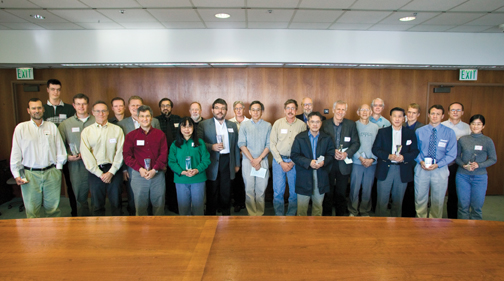 The 2005 Excellence in Technology Transfer Award recipients and presenters are (from left to right) Greg Newman, Frederic Gicquel, Len Pennacchio, Eddy Rubin, Sami Hahto, Jani Reijonen, Nick Palaio, Bill Barletta, Hoi-Ying Holman, Graham Fleming, George Moridis, Russell Wells, Steve Chu, Stephen Wilde, Rick Gough, Kin Man Yu, Wladek Walukiewicz, Joe Kwan, Karsten Pruess, Ka-Ngo Leung, Michael Kowalsky, Charles Gary (guest speaker), Stefan Finsterle, Qing Ji
The 2005 Excellence in Technology Transfer Award recipients and presenters are (from left to right) Greg Newman, Frederic Gicquel, Len Pennacchio, Eddy Rubin, Sami Hahto, Jani Reijonen, Nick Palaio, Bill Barletta, Hoi-Ying Holman, Graham Fleming, George Moridis, Russell Wells, Steve Chu, Stephen Wilde, Rick Gough, Kin Man Yu, Wladek Walukiewicz, Joe Kwan, Karsten Pruess, Ka-Ngo Leung, Michael Kowalsky, Charles Gary (guest speaker), Stefan Finsterle, Qing Ji
This year’s winners include Wladek Walukiewicz and Kin Man Yu of the Materials Sciences Division, who developed a multiband semiconductor that may become the basis for the most efficient solar cell yet. They constructed a material that may reach solar efficiencies as high as 60 to 70 percent, in comparison to current solar cell performance of around 25 percent.
Steve Holland and Nick Palaio of the Engineering Division developed a fully depleted, back-illuminated CCD. The CCD, which boasts high quantum efficiency, low noise, and high sensitivity, is used by telescopes around the globe to generate spectacular images of deep space, and is a key component in the SNAP satellite imager.
George Moridis, Stefan Finsterle, Michael Kowalsky, and Karsten Pruess of the Earth Sciences Division developed software called Tough-Fx. Among other functions, the software can simulate production from methane-hydrate deposits in permafrost and deep ocean sediments.
Len Pennacchio and Eddy Rubin of the Genomics Division won for their contributions in licensing a new gene that they discovered and named ApoAV. The gene greatly influences triglyceride and very low-density lipoprotein levels, both of which are a major risk factor for cardiovascular disease.
Ka-Ngo Leung, Qing Ji, Jani Reijonen, Sami Hahto, Joe Kwan, Tak Pui Lou, Rick Gough, and Bill Barletta of the Accelerator and Fusion Research Division, along with Russell Wells, Stephen Wilde, and Frederic Gicquel of the Engineering Division, created a portfolio of neutron source technologies that hold great promise for application in diverse fields.
Hoi-Ying Holman of the Earth Sciences Division developed a method that uses mid-infrared spectra to determine if a type of arterial cell is likely to develop into atherosclerotic plaques. This method could be developed into a test that allows physicians to identify patients who are susceptible to arthrosclerosis at a much earlier stage than currently possible.
Greg Newman of the Earth Sciences Division developed software that is used for electromagnetic modeling. This software was licensed to a Norwegian hydrocarbon exploration company that uses the software to search for underwater hydrocarbon deposits.
“The awards are meant to recognize a real milestone of success in these technologies,” says Cheryl Fragiadakis, head of Berkeley Lab’s Technology Transfer Department.
Look for articles in future issues of The View that explore what it took to shepherd some of these inventions from concept to marketplace.
DOE’s Director of Project Assessment Pulls No Punches in Talk
On Dec.1, a rainy Thursday afternoon, Dan Lehman, director of the Office of Project Assessment for DOE’s Office of Science, filled the Bldg 50 auditorium with a talk titled “Large Science Project Experience at the U.S. Department of Energy.” If the title sounds dry, the presentation was anything but.
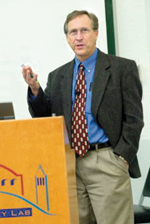 Dan Lehman
Dan Lehman
Jim Krupnick, director of Berkeley Lab’s Office of Institutional Assurance, introduced Lehman and promised a lesson in “understanding what makes big projects work.” But he cautioned the audience, packed with Berkeley Lab personnel whose past and present experiences embrace projects as diverse as the ALS, the SSC, the STAR detector at RHIC, ESnet, and SNAP, as well as visitors from Stanford and Lawrence Livermore with big-project trials of their own, “It’s not true that I told everybody if you sat through this talk, you’d get a free pass at the next Lehman Review.”
DOE describes Lehman Reviews as assessments of a project’s technical adequacy, cost, schedule, and management that, if they go badly, “can result in modifications to the project, work stoppage, and management changes.” Announcing his intention to “put the fear of God into you,” Lehman pulled no punches in discussing a variety of “successful and not so successful projects.”
He tagged critical stages in the process and warned what happens when a project doesn’t get top marks on its Project Assessment and Reporting System (PARS): “If you have the honor of being yellow or red on PARS, our senior management has to go talk to the Deputy Secretary and explain why.” Nor was he shy about the challenges of dealing with different agencies and levels of government.
Successes he discussed only briefly, although he took a moment to compliment Berkeley Lab’s timely delivery of the Spallation Neutron Source’s Front End, among other achievements.
“Projects live or die on their leadership,” Lehman said. His list of the elements of success includes selling the merits of big projects; meticulous planning while a new project still has the good will of its supporters; and realism, not optimism. “If you don’t have stable funding commitments, don’t start,” he warned.
And when problems arise, Lehman said, “Don’t be slow to look for solutions to problems. Look outside, for fresh ideas and expertise.” The bottom line: “Management, management, management.”
For tips on making projects succeed, visit the Office of Project Assessment website at http://www.science.doe.gov/opa/main.html
PROFILE
Opera Fan, Avid Runner Keeps Lab’s Rainfall Runoff in Compliance
Ginny Lackner has a deep devotion to the environment, which she passionately embraces in both her personal and professional lives.
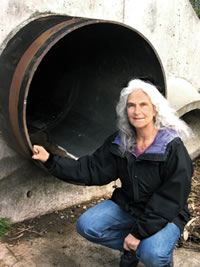 Ginny Lackner
Ginny Lackner
She credits her ecological awareness partly to an upbringing by German parents and having lived in Germany herself for several years. “In Europe, the population is much more sensitive to minimizing energy use and recycling, and has been practicing conservation for decades. Americans are very wasteful.”
Lackner has also made a career of caring for the environment, specifically, maintaining water quality. She runs the Water Quality Program in the Environmental Services Group, which is part of the Environment, Health, and Safety Division.
She makes sure the Lab isn’t polluting rainfall runoff that drains into Strawberry Creek, and eventually the Bay. To limit the discharge of unwanted materials, Lackner, working with other EH&S and Facilities Division personnel, has developed documents which include best management practices for use by staff, and a training program to raise awareness of the need to maintain clean storm water drainage (see www.lbl.gov/ehs/esg, under “Available Documents”).
Storm water is currently collected and monitored at five different Lab sites, says Lackner. Samples are analyzed for the presence of metals, diesel, nitrates, ammonia, and radiological isotopes, among other things. The Lab has been in compliance with a state storm water permit program since 1992, the year it was implemented.
Environmental Services also assisted with the recent construction of the Molecular Foundry. “There is a special set of requirements for construction projects to deal with erosion and other issues,” she said. “But we were able to acquire the necessary permit and mitigate the challenges of this steep site.”
In her spare time, Lackner — who is retiring at the end of the year — enjoys ushering at the San Francisco Opera, something she’s done for more than 30 years. Thinking back on this season, she said, “One of my all-time favorite operas is ‘Norma.’ But I was really impressed with this year’s premiere of ‘Dr. Atomic,’ which tells the story of Robert Oppenheimer in the days leading up to the release of the atomic bomb over Japan.”
If Lackner’s name sounds familiar to those at the Lab, it may be due to the numerous times she’s placed first or second in her age group at the annual Runaround competition. This past year, she placed first in the 60-and-over women’s category, earning her sixth medal overall.
“I got into the sport late in life, but now I run the nearby fire trails at least twice a week,” she explains. “I love to be alone in the forests.”
In Memoriam: Heinz Heinemann (1913-2005)
Heinz Heinemann, a veteran chemist with Berkeley Lab’s Materials Sciences Division, and one of the 20th century’s major scientific figures in the field of catalysis, died of pneumonia on Nov. 23, at Sibley Hospital in Washington, D.C. He was 92. During a 60-year career in industry and academia, Heinemann contributed to the invention and development of 14 commercial fossil fuel processes, received 75 patents and was the author of more than 150 publications. Among his inventions was a process for converting methanol to gasoline that is still in use today. In 1994, he received one of DOE’s top scientific honors, the Homer H. Lowry Award in Fossil Energy, as well as its Distinguished Scientist/Engineer award.
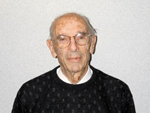 Heinz Heinemann
Heinz Heinemann
Heinemann was born and raised in Berlin, Germany and attended the University and Technische Hochschule there. At a time of rising Nazi anti-Semitism, his doctoral dissertation was rejected because he was Jewish. He eventually escaped to Switzerland, where he received his Ph.D. in physical chemistry from the University of Basel. He came to the United States in 1938 and became a U.S. citizen in 1944. After 40 years of working in the petroleum industry, including the last 10 years with the Mobil Research and Development Corpor-ation, Heinemann came to Berkeley Lab in 1978. He also, at that time, became a lecturer in UC Berkeley’s Department of Chemical Engineering.
During nearly 15 years of active research at the Lab, Heinemann investigated questions about coal gasification, catalytic coal liquefaction, hydrode-nitrification, nitrogen oxide emission control, and other fossil-fuel related issues. The research team he led invented and patented a process known as catalytic oxydehydrogenation, which involves a special catalyst that enables methane, the major component of natural gas, to be used as the basis for the production of petrochemicals.
Following his retirement from the Lab as a researcher in 1995, Heinemann moved to Washington, D.C., and, at the request of then Berkeley Lab director Chuck Shank, organized a highly successful series of seminars on Laboratory science and technology for federal program managers that continued up until his death.
In addition to his lengthy list of scientific accomplishments, Heinemann was also the founder of the journal Catalysis Reviews and served as its editor for 20 years. He also served as a consulting editor for more than 90 books in the Chemical Industries Series, published by Marcel Dekker, Inc. He cofounded the Philadelphia Catalysis Club, the Catalysis Society of North America and the International Congress of Catalysis. Among his many honors was his election to the National Academy of Engineering, the Cataly-sis Society, and the Murphree Award of the American Chemical Society.
Heinemann is survived by his wife of 10 years, Dr. Barbara Tenenbaum of Washington, D.C.; daughter, Sue Heinemann of Oakland, and son, Peter M. Heinemann of San Francisco. His first wife, Elaine P. Heinemann, died in 1993 after 46 years of marriage.
Contributions may be made in his memory to the Heinz Heinemann Memorial Fund. Donations should be made payable to the UC Berkeley Foundation and sent to the attention of Jane Scheiber, College of Chemistry, 420 Latimer Hall, #1460, University of California, Berkeley, CA 94720-1460.
Berkeley Lab-Triggered SNS Shooting for ’06 Debut
Sprawling across 80 acres on a ridge in eastern Tennessee, one of humankind’s most impressive monuments to scientific ingenuity is drawing closer to reality. The Spallation Neutron Source at Oak Ridge National Laboratory is stirring the research community with the kind of excitement that accompanies world-changing scientific events.
Here are the facts about the SNS. When it opens for business sometime next year, it will be one of the largest scientific facility construction projects that the United States has accomplished in several decades. It will provide the most intense pulsed neutron beams in the world dedicated to scientific research.
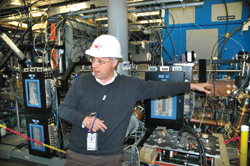
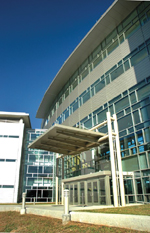 Stuart Henderson, Group Leader for Accelerator Physics at the Spallation Neutron Source in Oak Ridge, points out key aspects of the front end assembly, which was designed and built at Berkeley Lab. The front end occupies a small but significant portion of the SNS building, whose entrance (left) will welcome users when it opens in 2006.
Stuart Henderson, Group Leader for Accelerator Physics at the Spallation Neutron Source in Oak Ridge, points out key aspects of the front end assembly, which was designed and built at Berkeley Lab. The front end occupies a small but significant portion of the SNS building, whose entrance (left) will welcome users when it opens in 2006.
It is huge — 937 concrete pilings beneath the building would stretch 20 miles if laid end-to-end. The 70 megawatts of electric capacity required to run the SNS are enough to supply electrical service to 35,000 homes. And it is precise — alignment of the tunnel and accelerator components is so critical that even the curvature of the earth was factored into the construction. There are 100,000 points of control to be monitored in the system.
And none of it would work without the sophisticated trigger mechanism constructed at Berkeley Lab. Right now, the “Front End assembly” — the instrumentation that generates beams of negative hydrogen atoms for acceleration up to 1 billion volts of energy in one of the world’s longest linear accelerators — sits quietly in its chamber, awaiting activation. Designed and built in Building 71, then shipped part-by-part to Oak Ridge in 2002, the front end will initiate the process by which intense pulsed neutron beams are produced and scattered through the blasting of protons on a first-ever liquid mercury target. The ion beam will zip down its tunnel at 80 percent of the speed of light; at that rate, it could reach the moon in 1.5 seconds.
The spalled particles are guided to neutron instruments. Using these sophisticated tools, numbering up to 50 when the SNS is fully operational, some 2,000 scientists and engineers will explore the most intimate structural details of a vast array of novel materials that will form the basis for new technologies in telecommunications, manufacturing, transportation, information, biotechnology and health.
Like a massive jigsaw puzzle, the segments have been carefully put together and individually commissioned over the past five years. The Front End underwent and passed its functional testing in December 2002. The storage ring at the other end of the SNS is undergoing a readiness review this month. In March, beam will be directed to target, and if all goes well, the big machine’s commissioning will take place in April, with real work starting soon thereafter.
After that, the sky’s the limit. Never have structures and dynamic processes been analyzed at quite this scale, by an instrument quite this large. The target building alone weighs as much as a conventional 40-story building of the same footprint. The 80,000 cubic yards of concrete used to build the SNS is equivalent to a sidewalk three feet wide that would reach from San Francisco to Los Angeles (about 400 miles). Remarkable facts, but nothing compared to the promise of the research to come.
Prelude to an Earthquake?
A Berkeley Lab geophysicist has identified possible seismic precursors to two recent California earthquakes, including the 1989 Loma Prieta earthquake that wreaked havoc throughout the Bay Area.
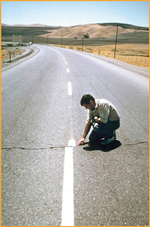
After sifting through seismic data from the two quakes, Valeri Korneev found a spike in the number of micro-earthquakes followed by a period of relative calm in the crust surrounding the quakes’ epicenters — months before the quakes occurred. Although more work needs to be conducted to determine whether other large quakes are foreshadowed by a similar rise and subsequent decline in small-magnitude tremors, Korneev’s analysis suggests that these peaks may be indicative of the total set of geological stresses that affect the timing and location of large earthquakes. Understanding this total stress picture may eventually make it possible to predict destructive earthquakes within a much shorter time frame than currently possible.
“Peaks in seismic activity in the crust surrounding a fault could help signal the arrival of large earthquakes,” says Korneev, of the Earth Sciences Division.
Predicting the location and date of impending earthquakes has so far remained elusive. Instead, scientists rely on earthquake forecasts, which are statistical tools that offer the probability of a quake occurring within a certain time frame. For example, the U.S. Geological Survey’s official seismic risk assessment gives a 27 percent chance that a magnitude 7.0 earthquake will occur on the Bay Area’s Hayward Fault sometime in the next 30 years.
But the prospect of more precise predictions has been hindered by a lack of detectable changes in a fault’s behavior prior to a quake. It’s as if some destructive earthquakes occur out of the blue, completely unannounced. Then, in 2004, a magnitude 6.0 quake rattled the town of Parkfield, Calif., where an extensive network of instruments and boreholes records every seismic hiccup in the area.
Soon after the quake, scientists pored over the network’s data to determine if the San Andreas Fault had dropped any clues that a quake was imminent. The first reports failed to find anything unusual. Korneev, however, decided to exclude from his analysis those tremors that occurred directly along the narrow portion of the San Andreas Fault that ruptured during the quake. Instead, he only included seismic activity that occurred along the fault’s flanks.
Minus the data from the fault-zone quakes, his new analysis revealed a possible harbinger. He found a sharp increase in seismic activity that started one year before the 2004 quake and peaked four to six months before the quake. This spike was followed by a steady decrease in activity during the last few months leading up to the quake.
Korneev also analyzed the 1989 magnitude 7.0 Loma Prieta earthquake. In the two months prior to the Oct. 17 quake, seismic activity increased to about eight times above normal levels. This peak was followed by a decrease in activity leading up to the powerful earthquake.
“Peaks in seismicity occurring several months before two recent large San Andreas Fault quakes indicate that they are good candidates for earthquake prediction studies,” says Korneev.
Lab-Directed Research and Development Awards Announced
Berkeley Lab Director Steve Chu announced the awards for the FY2006 Laboratory-Directed Research and Development (LDRD) program (see March 18 issue of The View). A total of over $12.2 million in operating and capital equipment is for 77 projects from a field of 165 proposals. Of these, 27 are new and 50 are continuation projects. The evaluations used input from divisional reviews as well as laboratory review committees.
In announcing the awards, Director Chu said, “Scientists for all proposals are to be commended for their creativity in offering many promising directions for Berkeley Lab. The competition was very high, and we could not fund many worthy proposals.”
LDRD FY2007 Call for Proposals
The FY2007 Call for Proposals for the Laboratory-Directed Research and Development (LDRD) program, which provides support for projects in forefront areas of science that can advance Berkeley Lab’s R&D competencies and open up new directions and capabilities, has been issued by Director Chu. This year the overall schedule will be moved forward approximately two months to enable earlier preliminary selections.
The Call for Proposals has been distributed to division directors and business managers. Principal investigators must submit proposals to division directors by Feb. 15.
After an internal divisional review and evaluation, division directors will forward the proposals with their rankings to the Director’s office in anticipation of the proposal reviews. As part of the proposal reviews, division directors will defend their rankings to review committees comprised of the director, deputy director, associated laboratory directors, and other division directors. Director Chu will make the final decisions.
Somewhat similar to prior years, for FY2007 a subset of proposals will be reviewed by a broader representation of all senior managers in a “Laboratory-wide” proposal review. These proposals generally are more cross-divisional and larger scale, and intended to initiate and/or develop major new strategic directions. If principal investigators and their division director anticipate the proposal would be appropriate for this forum, the scientist(s) must also discuss the proposal with the area’s associate laboratory director (ALD) prior to submission. Final selection of proposals for this review will be made by the deputy director in consultation with the ALDs.
The complete call, schedule, guidance, and forms are available for downloading off the Lab home page under the heading “Publications,” then LDRD, or directly at www.lbl.gov/Publications/LDRD/.
Lead-PI |
|
Title |
|
|
|
Ahmed |
|
Gas Phase Studies of the Building Blocks of Life |
|
|
|
Andersen |
|
Microarray Technology for Fungal Identification: Its Utility from the Environment to Homeland Security, Biomedicine, and Beyond |
|
|
|
Auer |
|
Molecular Microscopy and Tomography |
|
|
|
Balsara et al. |
|
Electron Microscopy of Soft Matter in Two and Three Dimensions |
|
|
|
Battaglia |
|
Advanced Detectors in Understanding the Early Universe |
|
|
|
Benson |
|
Scientific Basis for Advance Geologic Storage Technologies |
|
|
|
Bishop |
|
Autonomous Sensors for Ocean Dissolved Organic Matter |
|
|
|
Byrd |
|
High-Stability Beam Handling in Electron Storage Rings with Applications to High Energy Colliders and Light Sources |
|
|
|
Celniker |
|
Modeling Human Disease In Drosophila melanogaster |
|
|
|
Chang |
|
Oxygen Catalysis for Biomimetic Energy Conversion Chemistry |
|
|
|
Chevassut |
|
Cryptographic Foundations for New Generation Distributed Systems |
|
|
|
Coates et al. |
|
An Investigation of the Microbial Processes Involved in Electron Transfer onto the Anode of a Biological Fuel Cell |
|
|
|
Conboy |
|
Unmasking the Human Genome Alternative Splicing Program |
|
|
|
Crooks |
|
Statistical Dynamics of Protein Evolution |
|
|
|
Dahmen |
|
Techniques of Sample Controls for a Transmission Electron Aberration-Corrected Microscope |
|
|
|
Denes et al. |
|
Novel Imaging Detectors for Materials and Biology Research |
|
|
|
DePaolo |
|
Micro-Characterization and Chemical Micro-Dynamics of Atmospheric Mineral Dust |
|
|
|
Earnest |
|
High-Throughput Production of Proteins and Protein Complexes |
|
|
|
Fischer |
|
Constraining Ammonia Emission Inventories for Control of Air Quality |
|
|
|
Fletcher |
|
Synthetic Cytoskeleton: Protrusive Structure for Reconstituted Cell Motility |
|
|
|
Francis |
|
Tailoring the Self Assembly of Functionalized
|
|
|
|
Frei |
|
Visible Light-driven Water Oxidation in Mesoporous Solids |
|
|
|
Gadgil |
|
Arsenic Electrochemistry |
|
|
|
Gilbert |
|
Behavior and Impact of Nanoparticles |
|
|
|
Glaeser |
|
Improved Phase Contrast for Cryo-EM Biological Machines and Subcellular Structure |
|
|
|
|
|
Magnetic Control of Spatial Organization at Bio-Membranes |
|
|
|
Heeger |
|
Designing a Novel Reactor Neutrino Oscillation Experiment for Measuring the Unknown Mixing Angle Theta-13 |
|
|
|
Holman |
|
Compositional and Functional Analysis of Cell Walls During Metal-Bacterial Interactions |
|
|
|
Howells |
|
Coherent X-Ray Diffraction Imaging (CXDI) |
|
|
|
Hugenholtz |
|
Metagenomics-Enabled Analysis of Termite Hindgut Microbiota for Biomass Conversion and Cleaner Energy |
|
|
|
Isacoff et al. |
|
Light-Activated and Regulated Ion Channels and Transporters |
|
|
|
Jagust |
|
Neuroimaging with Advanced Molecular Probes |
|
|
|
Johnson et al. |
|
Highly Efficient PLED Through Polymer Morphology Control |
|
|
|
Kaindl |
|
Terahertz-Frequency Conductivity and Ultrafast Optical Excitations in Single-Walled Carbon Nanotubes |
|
|
|
Kirz |
|
Lenless Imaging of Yeast Cells |
|
|
|
Konerding |
|
Software Application Infrastructure for Efficiently Managing Large-Scale Computational Biology Experiments |
|
|
|
Kostecki |
|
Surface Plasmon-Enhanced Photovoltaic Device |
|
|
|
Leone |
|
Time-resolved X-Ray Absorption Spectroscopy of Metalloporphyrins |
|
|
|
Lesko |
|
Research and Development for Double Beta Decay (DBD) Experiments |
|
|
|
Lester et al. |
|
Development and Application of Quantum
|
|
|
|
Lidia et al. |
|
Critical Accelerator Technologies for Advanced Light Sources |
|
|
|
Liphardt |
|
Rapid Characterization of Microbial RNAs Using Artificial Nanopores |
|
|
|
Logan et al. |
|
Enabling High Energy Density Physics at LBNL |
|
|
|
Marcus, et al. |
|
Measurement of Molecular Shape and Assembly Using X-Ray Scattering |
|
|
|
Markowitz et al. |
|
Integrated Microbial Community Genomes Data Management System |
|
|
|
Martin |
|
Left-Handed Nanoscale Meta-Materials: Towards the Optical Domain |
|
|
|
McMahan |
|
Establishing New Capabilities in Nuclear Astrophysics and Radiation Biology Using Neutrons at the 88-Inch Cyclotron |
|
|
|
Miller et al. |
|
The
|
|
|
|
Moridis |
|
Interrelation of Global Warming and Hydrate Dissociation in Oceanic Accumulations |
|
|
|
Murayama |
|
New Directions for Theoretical Physics at the TeV-Scale |
|
|
|
Nakagawa |
|
New Technology for Permeability Enhancement for Natural Gas Extraction in Tight Reservoirs |
|
|
|
Neumark |
|
Photoionization and Photodetachment of Doped He Nanodroplets |
|
|
|
Newman |
|
Analysis of High-Temperature Polymer-Electrolyte Fuel-Cell Phenomena |
|
|
|
|
|
Coupled Modeling of Hydrology, Nutrient Cycling, and Vegetation: Applications to Water Quality and Water Balance |
|
|
|
Oliker |
|
Enhancing Commodity Scalar Processors with Vector Components for Increased Scientific Productivity |
|
|
|
Orenstein, Ramesh |
|
Science and Technology of Quantum Materials |
|
|
|
Pennacchio et al. |
|
Development of Cost Effective Sequence-Based Technologies to Identify Genomic Alterations in Cancer |
|
|
|
Phair |
|
Improved Spectroscopy of Weakly Bound States in Nuclei |
|
|
|
Pinar et al. |
|
Advanced Computational Tools for Electric Power Systems |
|
|
|
Prausnitz |
|
Properties of New Ionic Liquids for Electrochemical Applications and for Extraction of Heavy-Metal Cations from Wastewaters |
|
|
|
Rescigno et al. |
|
Advanced Computational Methods for Photon-Molecule Collision Processes |
|
|
|
Ritchie |
|
Aging, Disease and the Mechanical Response of Biological Tissues, Specifically Human Bone |
|
|
|
Romano |
|
Statistical Feature Modeling for Scientific Data Via Basis Decomposition |
|
|
|
Rotenberg |
|
NanoARPES: A New Detector for Nanometer-scale Electronic Structure Measurements |
|
|
|
Russo et al. |
|
Photons to Fuels – The Electrochemical Reduction of Carbon Dioxide to Hydrocarbons |
|
|
|
Sathaye |
|
World Energy Scenarios: The Crucial Role of Energy Demand |
|
|
|
Schild |
|
Determine if PIR51 is a Potential Tumor Suppressor Gene Similar to BRCA2 |
|
|
|
Scholl |
|
Ultrafast Magnetization Dynamics |
|
|
|
Somorjai |
|
Electron Glow Generated by Gas Phase Exothermic Catalytic Reactions Using Metal-Semiconductor Nanodiodes |
|
|
|
Souza |
|
Computational and Theoretical Studies of Bulk and Nano Solid Systems |
|
|
|
Steefel |
|
Biogeochemical Reaction Rates and Pathways in Porous Media |
|
|
|
Tilley |
|
New Approach for the Catalytic Conversion of Methane and Other Inert Hydrocarbons |
|
|
|
Tyliszczak |
|
Versatile Mini-Scanning Transmission X-Ray Microscope (mSTXM) |
|
|
|
Vetter |
|
Conceptual Study for a Novel Nuclear Astrophysics Accelerator Facility to Measure Nuclear Reactions That Power the Stars |
|
|
|
Vishwanath |
|
Experimental Signatures of Deconfined Phases and Transitions |
|
|
|
Wilkening |
|
Extended First Order System Least Squares Finite Elements |
|
|
|
Zolotorev |
|
Low Energy Spread Electron Source |
In Memoriam: Victor Perez-Mendez (1923-2005)
Victor Perez-Mendez, a physicist who worked at Berkeley Lab for 40 years starting in 1955, passed away on Nov. 1, at Kaiser Hospital in Oakland, following a long illness. He was 82. Lab employees who attended state-of-the-lab addresses, or other all-hands meetings during the 1980s and early 90s, might remember Perez-Mendez who could almost always be counted on to pose provocative questions.
He began his career here specializing in particle detectors for high-energy and nuclear physics, but in 1969 he was given a joint appointment in the Radiology Department of the University of California at San Francisco and began focusing more on medical physics. In his last years at the Lab, he helped develop a digital radiography technique for obtaining dental images using about one-tenth the x-ray radiation dose required for film-based images.
“Victor Perez-Mendez was a scientist’s scientist in the combined tradition of science, research, and education,” said Berkeley Lab chemist and long-time collaborator Dale Perry. “He was extremely innovative and productive in his research and was representative of the caliber of scientist that put this Laboratory on the map both nationally and internationally. He will be sorely missed.”
Perez-Mendez was born in Guatemala in 1923. He lived there for eight years, then moved with his family to Manchester, England, and eventually to Jerusalem, where his parents had been born. He attended St. George’s Academy and the Hebrew University, where he received his undergraduate and MS degrees. In 1947 he began studying physics under Nobel Prize Winner I. I. Rabi at Columbia University. He received his Ph.D. in 1951 and remained at Columbia as a post-doctoral fellow until 1953. He came to the University of California in 1953 as an investigator at Lawrence Livermore National Laboratory. Two years later he transferred to Berkeley Lab, where he spent the rest of his scientific career.
Perez-Mendez was a Fellow of the American Physical Society, the Institute of Electrical and Electronics Engineering, the New York Academy of Sciences, and the American Association for the Advancement of Science. In 1992, he was awarded patents for an amorphous silicon radiation detector, and for an apparatus that improved the spatial resolution of particle detectors.
He is survived by his wife of 56 years, Gladys Cobert, and his son David Perez-Mendez, both of whom reside in Berkeley. Those wishing to make a donation in Perez-Mendez’s honor should send it to the educational institute of their choice.
People, Awards, and Honors
Mathematician Wins Engineering Medal
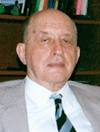 Grigory Isaakovich Barenblatt
Grigory Isaakovich Barenblatt
The American Society of Mechanical Engineers announced that Grigory Isaakovich Barenblatt of the Computational Research Division’s Mathematics Group was awarded the Timoshenko Medal “for seminal contributions to nearly every area of solid and fluid mechanics, including fracture mechanics, turbulence, stratified flows, flames, flow in porous media, and the theory and application of intermediate asymptotics.” The medal was established in 1957 and commemorates mechanical engineer Stephen Timoshenko’s contributions as an author and teacher.
Mathematician Gets Fernbach Award
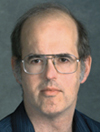 John Bell
John Bell
John Bell, a senior staff mathematician who leads the Center for Computational Sciences and Engineering in the Lab’s Computational Research Division, has been named as the recipient of the 2005 Sidney Fernbach Award. The Fernbach Award is given by the Institute of Electrical and Electronics Engineers for an outstanding contribution in the application of high performance computers using innovative approaches.
Chemla Receives DOE ‘Distinguished’ Award
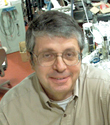 Daniel Chemla
Daniel Chemla
Daniel Chemla, director of Berkeley Lab’s Advanced Light Source, recently received a Department of Energy Distinguished Associate Award. The honor recognizes his “many accomplishments, contributions, and leadership in both science and science management,” according to the citation signed by DOE Secretary Samuel Bodman. It went on to say: “You have brought the Advanced Light Source to a prominent role as a national and international scientific user facility. Your pioneering research in nanoscience and dedication to the establishment of the Department of Energy Nanoscience Research Centers has made it a reality.”
ALS Scientist Wins Humboldt Award
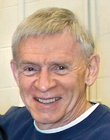 Charles Fadley
Charles Fadley
Charles Fadley, with the Lab Advanced Light Source, has received a Helmholtz-Humboldt Award from the Alexander von Humboldt Foundation. Each year, the German-based Helmholtz Association of 15 government research laboratories and the Humboldt Foundation jointly grant up to six research awards to internationally acknowledged scientists from abroad in recognition of their achievements. The awards come with cash and an invitation to undertake research in Germany with government and university partners. Fadley, a UC Davis physics professor, is a leading authority on photoelectron spectroscopy. While in Germany, he will pursue standing wave studies of nanostructures and spin-polarized dichroic holography.
Life Scientist Moses Is Engineering Fellow
 William Moses
William Moses
William Moses, with the Lab’s Life Sciences Division, has been inducted as a fellow of the Institute of Electrical and Electronics Engineers. He was recognized for the development and application of efficient, high-resolution position tomography. Moses is a principal scientist with the division’s Instrumentation Group, which focuses on positron and single photon emission imaging.
In Memoriam
BES Team Leader Bill Oosterhuis
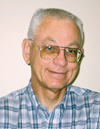 Bill Oosterhuis
Bill Oosterhuis
Bill Oosterhuis, a Team Leader for Condensed Matter Physics and Materials Chemistry in the Office of Basic Energy Sciences, and formerly a researcher at the Advanced Light Source, passed away on Nov. 16. Before joining DOE, Oosterhuis was a program manager and section head in the Division of Materials Research at the National Science Foundation. From 1986-1987, he was on a detail assignment at the White House Office of Science and Technology Policy, and he also held a faculty position at Carnegie-Mellon University. Oosterhuis was a fellow of both the American Physical Society and the American Association for the Advancement of Science.
Lab Scientist
Tony Vuletich
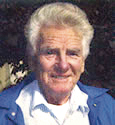 Tony Vuletich
Tony Vuletich
Tony Vuletich, a scientist who worked at Berkeley Lab from 1951 until his retirement in 2004, passed away on Oct. 7 at the age of 79. Among his many achievements were significant contributions to several medical imaging instruments, including the liquid xenon proportional wire chamber, and the Donner 280 crystal and Donner 600 crystal positron tomographs. “Tony Vuletich brought a wealth of experience and talent to any project he worked on. He was a pleasure to work with and solved problems that made life easier for the rest of the research team,” says Stephen Derenzo of the Life Sciences Division.
Flea Market Moves Online
The Lab’s Flea Market, a classified ad service that employees can use to list items they have for sale, rent, or to give away, now has its own website and will no longer be listed in The View.
To place an ad, visit the Flea Market website (www.lbl.gov/fleamarket).
fleamarket) and click on the “Place an Ad” link. After input of an LDAP password, staff can submit their information using an electronic form. Images of sale items can also be included. Upon editorial approval, the ads will remain online for up to 30 days. Those who place ads can manage them after initial posting by logging into the website.
Staff wanting to view ads can select from several categories (such as “rentals and roommates” or “computers and software”), or use the search function to find items. No login is required to view ads. If interested in an item, potential buyers can e-mail the seller directly from the site.
A link to the Flea Market will appear in the “Info” box of Today at Berkeley Lab.
For more information about this new service, call x4698 or e-mail lhunter@lbl.gov.